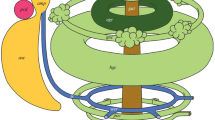Abstract
The growth of the adult echinoderm body is addressed here in the echinoid Holopneustes purpurescens in a study of the early development of the secondary podia along the five radial canals of the adult rudiment. At a stage when the first four secondary podia have formed along each radius oral to the primary podium, two podia are on one side of the radius and two are on the other side, all at a different distance from the primary podium. The pattern of the connexions of these secondary podia to the radial canals changes in successive radii in a manner similar to Lovén’s law for skeletal plates and matches the reported sequence in the times at which the first ambulacral skeletal plates form in the adult echinoid rudiment. A similar pattern is described for the reported origins of the secondary podia in apodid holothurians. A common plan for the growth of the body types is described for echinoids, asteroids, holothurians and concentricycloids. The five metameric series of secondary podia formed in echinoderms have a coelomic developmental origin like the single metameric series of somites formed in the axial structures of chordates.








Similar content being viewed by others
References
Baker AN, Rowe FWE, Clarke HES (1986) A new class of Echinodermata from New Zealand. Nature 321:862–864
Cox G (2007) Optical imaging techniques in cell biology. CRC Press, Boca Raton
David B, Mooi R (1998) Major events in the evolution of echinoderms viewed by the light of embryology. In: Mooi R, Telford M (eds) Echinoderms: San Franscisco. Balkema, Rotterdam, pp 21–28
David B, Mooi R, Telford M (1995) The ontogenetic basis of Lovén’s rule clarifies homologies of the echinoid peristome. In: Emson R, Smith A, Campbell A (eds) Echinoderm research 1995. Balkema, Rotterdam, pp 155–164
Engstrom NA (1980) Development, natural history and interstitial habits of the apodous holothurian Chiridota rotifera (Pourtales, 1851) (Echinodermata: Holothuroidea). Brenesia 17:85–95
Gemmill JF (1912) The development of the starfish Solaster endeca Forbes. Trans Zool Soc Lond 20:1–71
Gemmill JF (1914) The development and certain points in the adult structure of the starfish Asterias rubens, L. Phil Trans R Soc B 205:213–294
Gordon I (1926) The development of the calcareous test of Echinus miliaris. Phil Trans R Soc Lond B 214:259–312
Heinzeller Th, Welsch U (1999) The complex of notochord/neural plate in chordates and the complex of hydrocoel/ectoneural cord in echinoderms—analogous or homologous? In: Candia Carnevali MD, Bonasoro F (eds) Echinoderm research 1998. Balkema, Rotterdam, pp 285–290
Hotchkiss FHC (1978) Studies on echinoderm ray homologies: Lovén’s law applies to paleozoic ophiuroids. J Paleontol 52:537–544
Hotchkiss FHC (2000) On the number of rays in starfish. Amer Zool 40:340–354
Hyman LH (1955) The invertebrates: echinodermata IV. McGraw-Hill, New York
Lovén S (1874) Études sur les échinoïdées. K Vet Akad Handl 11(7):1–91
MacBride EW (1896) The development of Asterina gibbosa. Q J Microsci Sci 38:339–411
Mah CL (2006) A new species of Xyloplax (Echinodermata: Asteroidea: Concentricycloidea) from the northeast Pacific: comparative morphology and a reassessment of phylogeny. Invert Biol 125:136–153
Menker D (1970) Lebenszyklus, Jugendentwicklung und Geschlechtsorgane von Rhabdomolgus ruber (Holothuroidea: Apoda). Marine Biol 6:167–186
Minsuk SB, Turner FR, Andrews ME, Raff RA (2009) Axial patterning of the pentaradial adult echinoderm body plan. Dev Genes Evol 219:89–101
Mooi R, David B (2008) Radial symmetry, the anterior/posterior axis, and echinoderm Hox genes. Annu Rev Ecol Evol Syst 39:43–62
Mooi R, David B, Marchand D (1994) Echinoderm skeletal homologies: classical morphology meets modern phylogenetics. In: David B, Guille A, Féral JP, Roux M (eds) Echinoderms through time. Balkema, Rotterdam, pp 87–95
Morris VB (1995) Apluteal development of the sea urchin Holopneustes purpurescens Agassiz (Echinodermata: Echinoidea: Euechinoidea). Zool J Linn Soc 114:349–364
Morris VB (2001) Implications of a proposed anterior–posterior bilateral body axis in echinoderms. In: Barker M (ed) Echinoderms 2000. Balkema, Rotterdam, pp 35–38
Morris VB (2007) Origins of radial symmetry identified in an echinoderm during adult development and the inferred axes of ancestral bilateral symmetry. Proc R Soc B 274:1511–1516
Morris VB, Byrne M (2005) Involvement of two Hox genes and Otx in echinoderm body-plan morphogenesis in the sea urchin Holopneustes purpurescens. J Exp Zool (Mol Dev Evol) 304B:456–467
Morris VB, Selvakumaraswamy P, Whan R, Byrne M (2009) Development of the five primary podia from the coeloms of a sea star larva: homology with the echinoid echinoderms and other deuterostomes. Proc R Soc B 276:1277–1284
Raff RA, Popodi EM (1996) Evolutionary approaches to analyzing development. In: Ferraris JD, Palumbi SR (eds) Molecular zoology: advances, strategies, and protocols. Wiley, New York, pp 245–265
Rowe FWE, Baker AN, Clark HES (1988) The morphology, development and taxonomic status of Xyloplax Baker, Rowe and Clark (1986) (Echinodermata: Concentricycloidea), with the description of a new species. Proc R Soc Lond B 223:431–459
Runnström Sv (1927) Über die Entwicklung von Leptosynapta inhaerens. Bergens Mus Årbok 1:1–80
Acknowledgements
Author information
Authors and Affiliations
Corresponding author
Additional information
Communicated by H. Nishida
Rights and permissions
About this article
Cite this article
Morris, V.B. On the sites of secondary podia formation in a juvenile echinoid: growth of the body types in echinoderms. Dev Genes Evol 219, 597–608 (2009). https://doi.org/10.1007/s00427-010-0321-9
Received:
Accepted:
Published:
Issue Date:
DOI: https://doi.org/10.1007/s00427-010-0321-9




